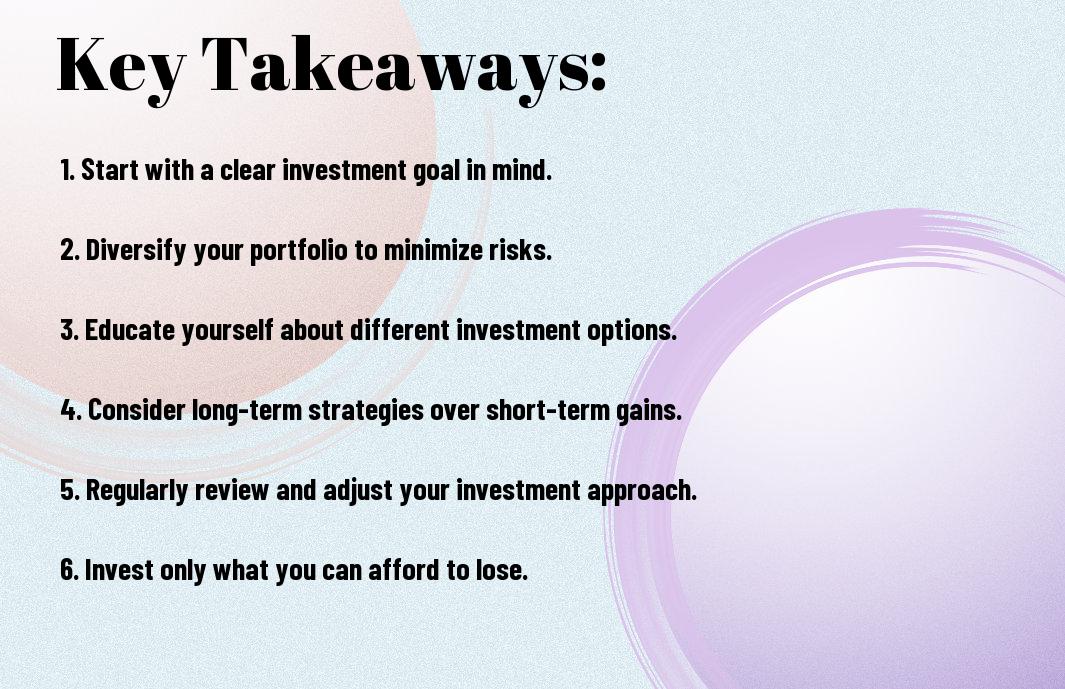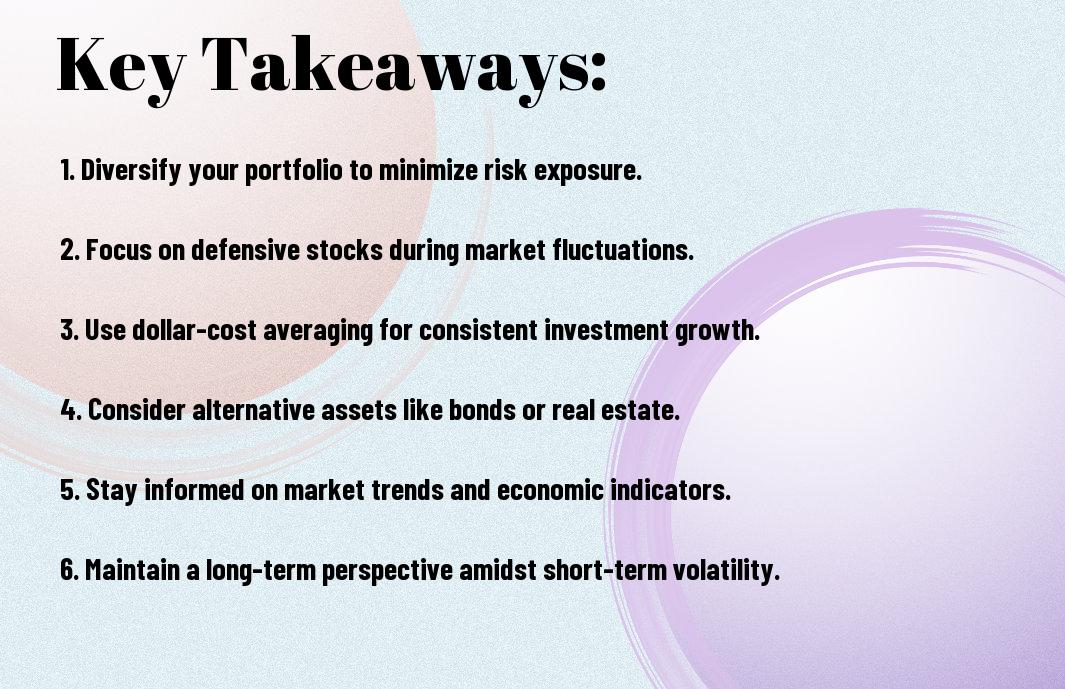Strategies for successful investing as a first-timer can turn your financial aspirations into reality. As you begin on this journey, it’s necessary to equip yourself with valuable knowledge and practical techniques that can guide your decision-making. In this blog post, we’ll explore the top 10 strategies tailored for you, enabling you to navigate the world of investments with confidence and commitment. Whether you’re looking to grow your wealth or secure your financial future, these insights will empower you to make informed choices every step of the way.
Key Takeaways:
- Diversification: Spread your investments across various asset classes to minimize risk.
- Research: Conduct thorough research on potential investments to make informed decisions.
- Long-term perspective: Focus on long-term gains rather than short-term fluctuations in the market.
- Set goals: Define clear investment objectives to guide your strategy and decisions.
- Start small: Begin with a modest investment to gain experience without overwhelming risk.

Understanding Investment Basics
The foundation of successful investing lies in understanding the basics. Familiarizing yourself with key concepts and the principles of investing will enhance your decision-making skills and confidence as a first-time investor. It’s crucial to have a solid grasp on how investments work and the different options available to you, as this knowledge will guide you toward creating a diverse portfolio that aligns with your financial goals.
Key Terminology
Terminology plays a significant role in your investing journey. Knowing the meaning of common terms will empower you to navigate the financial landscape with ease. Here are some important terms you should familiarize yourself with:
| Term | Definition |
| Asset | Any resource owned that has economic value. |
| Dividend | A payment made by a corporation to its shareholders. |
| Portfolio | A collection of investments owned by an individual or institution. |
| Risk Tolerance | The degree of variability in investment returns you are willing to withstand. |
| Return on Investment (ROI) | A measure of the profitability of an investment. |
Types of Investments
One crucial part of investing is understanding the various types of investments. Each type carries its own risk and return profile, making it vital for you to choose what best fits your financial strategy. Here are some common types of investments to consider:
- Stocks
- Bonds
- Mutual Funds
- Exchange-Traded Funds (ETFs)
- Real Estate
Knowing the characteristics of each investment type will help you build a balanced portfolio that reflects your financial goals.
| Type | Description |
| Stocks | Ownership shares in a company. |
| Bonds | Debt securities issued by corporations or governments. |
| Mutual Funds | A pool of money invested in various assets managed by professionals. |
| ETFs | Funds that trade on stock exchanges, similar to stocks. |
| Real Estate | Property investment involving residential or commercial assets. |
Another important aspect is to be aware of the potential risks associated with each investment type. Evaluating these risks relative to your investing goals is paramount. Consider these factors:
- Market volatility
- Liquidity
- Investment horizon
- Management costs
- Economic conditions
Knowing these elements will empower you to make informed investment choices that align with your objectives and risk appetite.
Setting Financial Goals
One of the first steps in your investment journey is establishing clear financial goals. These goals will guide your investment decisions and help you determine your risk tolerance, time horizon, and overall strategy. By identifying what you want to achieve, whether it’s saving for retirement, buying a home, or funding education, you can create a roadmap that aligns your investments with your aspirations.
Short-Term vs Long-Term Goals
Financial goals can be divided into short-term and long-term categories. Short-term goals typically involve achieving objectives within a few months to a few years, like building an emergency fund or saving for a vacation. Long-term goals, on the other hand, extend beyond five years and include aspirations like retirement or wealth accumulation. Understanding the difference helps you allocate your resources and investment vehicles effectively.
Importance of a Financial Plan
Below is the significance of having a well-thought-out financial plan. A financial plan serves as a comprehensive blueprint that outlines your financial objectives and the strategies to achieve them. By systematically analyzing your income, expenses, and investment opportunities, you can make informed decisions that help you reach your goals more efficiently.
Goals in your financial plan not only clarify what you want to achieve but also improve your overall financial discipline. A clear plan can help you stay focused and motivated, making it easier to adapt to life changes or unexpected expenses. Additionally, setting specific, measurable goals allows you to track your progress, adjust your strategies when necessary, and celebrate your achievements along the way.

Building a Diversified Portfolio
Your investment success largely hinges on building a diversified portfolio. A well-rounded mix of assets can help mitigate risks and enhance your potential for returns. By spreading your investments across various sectors and classes, you not only safeguard against market fluctuations but also create opportunities for growth. For more insights, check out the 10 Best Tips for Beginning Investors.
What is Diversification?
Across the investment landscape, diversification refers to the practice of allocating funds across a range of assets to reduce exposure to any single investment. By investing in a mixture of stocks, bonds, and other securities, you can lessen the impact of a poor-performing asset on your overall portfolio.
Asset Allocation Strategies
Below are some effective asset allocation strategies to consider when constructing your portfolio. Diversification involves specific ratios that reflect your investing goals, risk tolerance, and time horizon. You may choose a conservative approach with more bonds and fewer stocks, or a more aggressive strategy that leans heavily on equities.
Considering you might have different financial objectives, it’s important to tailor your asset allocation strategy to fit your unique circumstances. As a starting point, many investors follow the rule of 60/40—60% in stocks and 40% in bonds—while others adjust this based on age or market conditions. Regularly reviewing and rebalancing your portfolio can ensure optimal performance over time, adapting to shifts in both personal goals and market dynamics.
Researching Investment Options
To make informed decisions about your investments, it’s important to research various options available to you. Consider exploring diverse opportunities, such as stocks, bonds, and mutual funds. Familiarizing yourself with different asset classes can help you identify what aligns best with your financial goals. For guidance, visit 10 Investing Concepts Beginners Need to Learn to deepen your understanding.
Fundamental vs Technical Analysis
Before choosing your investment strategy, it’s vital to understand fundamental and technical analysis. Fundamental analysis focuses on evaluating a company’s financial health, examining earnings, dividends, and overall market position. Conversely, technical analysis analyzes price movements and trading volumes to forecast future price behavior. Balancing both methods can provide you with a well-rounded approach to making sound investment decisions.
Utilizing Online Resources
About leveraging online resources, numerous platforms offer valuable insights into market trends and investment strategies. Utilize websites, blogs, and forums dedicated to investing to expand your knowledge. These resources often provide tips, guides, and expert opinions that can enhance your understanding of your options.
It is important to navigate and critically evaluate the information available online. Look for reputable sources that are regularly updated and cater to beginner investors. Joining investment communities or forums can also connect you with experienced investors who can share tips and advice as you begin on your investment journey.
Choosing the Right Investment Account
Keep in mind that selecting the appropriate investment account is imperative for aligning with your financial goals and strategies. The right account can provide notable benefits, including tax advantages and better management of your investments. Take your time to assess your options to ensure that you set a solid foundation for your investment journey.
Types of Investment Accounts
Keep in mind that various investment accounts cater to different needs and objectives. Your choice will depend on factors like your investment goals, tax situation, and level of risk tolerance. Here are a few types of accounts you might consider:
- Individual Brokerage Account
- Retirement Accounts (like IRAs and 401(k)s)
- Education Savings Accounts (like 529 plans)
- Taxable Investment Accounts
- Robo-Advisors
After defining your goals, you can make a more informed decision about which investment account suits you best.
| Type of Account | Purpose |
| Individual Brokerage Account | General investing with no tax advantages |
| Traditional IRA | Retirement savings with tax-deferred growth |
| Roth IRA | Retirement savings with tax-free withdrawals |
| 401(k) | Employer-sponsored retirement plan with matching |
| 529 Plan | Education savings with tax-free growth for tuition |
Tax Considerations
Above all, understanding the tax implications of different investment accounts will help you maximize your returns. Different accounts come with unique tax benefits or liabilities that can significantly influence your overall investment strategy. It’s imperative to be aware of how your investments will be taxed to avoid unexpected costs.
Further, different types of accounts can lead to various tax situations. For instance, contributions to a Traditional IRA may reduce your taxable income now, allowing for tax-deferred growth, while a Roth IRA provides tax-free withdrawals in retirement. It is wise to consult with a tax professional to understand your specific situation and optimize your investment strategy accordingly.
Monitoring and Rebalancing Your Portfolio
For successful investing, it’s crucial to monitor and rebalance your portfolio regularly. Over time, market movements can cause your asset allocation to drift from your initial strategy, impacting your risk tolerance and overall investment objectives. By keeping an eye on your holdings and making necessary adjustments, you can stay aligned with your financial goals and adapt to changing market conditions.
Tracking Investment Performance
Rebalancing your portfolio involves consistently tracking the performance of your investments. Use financial tools and resources to assess how each asset is performing relative to others and measure overall portfolio growth. By evaluating both individual and collective performances, you can identify any areas needing attention and ensure your strategy remains effective.
When and How to Rebalance
To effectively rebalance your portfolio, you should periodically review your asset allocation, ideally on a semi-annual or annual basis. Adjust your investment mix by selling over-performing assets and purchasing underperforming ones to maintain your desired allocation. This practice allows you to stay within your risk tolerance and seize opportunities presented by market fluctuations.
It’s important to consider both market conditions and changes in your personal financial situation when deciding how often to rebalance. Assessing your investments after significant market movements or life events, such as a new job or a change in financial goals, can provide clarity on necessary adjustments. By establishing a regular rebalancing schedule, you’ll not only manage risk effectively but also capitalize on the natural ebb and flow of the market.
Learning from Experience
Once again, the value of experience cannot be underestimated in your investment journey. Each decision you make, whether it leads to success or failure, provides valuable insights that can shape your future strategies. Embrace each lesson learned, as this will boost your confidence and enhance your approach moving forward. By reflecting on your past choices, you’ll gain a clearer understanding of what to pursue or avoid, ultimately making you a more savvy investor.
The Importance of Patience
Before submerging into the world of investing, recognize that patience is imperative. Markets fluctuate, and it often takes time for investments to yield significant returns. By maintaining a long-term perspective, you can avoid the trap of reacting impulsively to short-term changes and focus on your overall financial goals.
Seeking Professional Advice
Importance of consulting with financial advisors can greatly enhance your investment strategy. Their expertise allows you to make informed decisions and better understand the complexities of financial markets.
Indeed, working with a professional can provide you with tailored advice that reflects your unique financial situation and investment goals. Financial advisors can offer insights into asset allocation, risk management, and market trends, enabling you to navigate investment opportunities more effectively. By leveraging their experience, you will feel more confident in your decisions, potentially accelerating your learning curve and optimizing your returns in the long run.
Summing up
Drawing together the insights provided, initiateing on your investment journey requires a thoughtful approach. By applying these top 10 strategies, you can build a solid foundation, manage risks effectively, and enhance your financial literacy. Focus on setting clear goals, diversifying your portfolio, and staying informed about market trends. With patience and commitment, you can make informed decisions that align with your financial aspirations, ultimately leading to a more prosperous future in investing.
Q: What are the first steps a new investor should take before starting to invest?
A: Before venturing into the world of investing, first-time investors should focus on education and planning. Start by learning the basics of investing, including different asset classes, how the stock market works, and the importance of diversification. Creating a financial plan that outlines your investment goals, risk tolerance, and time horizon is crucial. This plan will serve as a guide for your investment decisions. Additionally, establishing an emergency fund and paying off high-interest debt should be priorities before committing significant amounts of money to the investment landscape.
Q: How important is diversification in an investment portfolio?
A: Diversification is a key strategy for managing risk in an investment portfolio. By spreading investments across various asset classes (such as stocks, bonds, and real estate) and sectors (like technology, healthcare, and energy), investors reduce their exposure to any single investment’s poor performance. This practice helps to stabilize returns over time, as different assets often react differently to market changes. First-time investors should strive for a well-balanced portfolio that aligns with their risk tolerance and investment timeline, allowing them to withstand market fluctuations more effectively.
Q: What are some common mistakes first-time investors make, and how can they be avoided?
A: New investors often fall into several pitfalls that can hinder their investing journey. One common mistake is not conducting thorough research before making investment choices. To avoid this, investors should take the time to analyze potential investments, understanding their fundamentals and market dynamics. Another frequent error is attempting to time the market, which can lead to rushed decisions and missed opportunities. Instead, adopting a long-term investment perspective can help mitigate this risk. Lastly, a lack of patience can result in impulsive reactions to market volatility; maintaining a disciplined approach and sticking to the investment plan can lead to more favorable outcomes over time.





